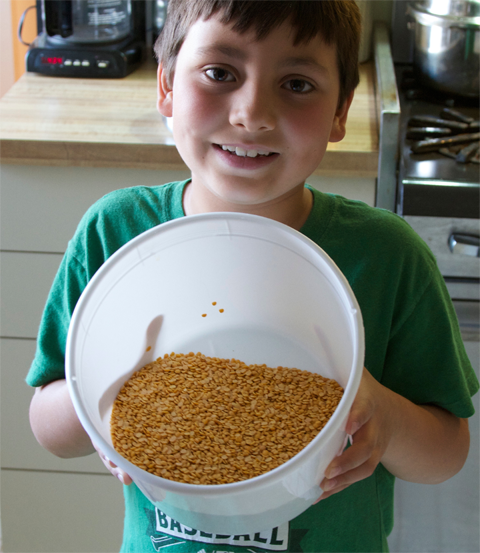 PRESENTING PIGEON PEAS Shweta's son shows us toor dal, his favorite Indian legume.
Photo by Lindsay Sterling. |
I’d tasted dals from time to time in Indian restaurants and liked them, but never had the occasion to cook one. I guess I was intimidated. What were dals even made of? And how many kinds were there? It seemed like dozens, perhaps a hundred. I asked my Indian friend, Shweta Galway, if she’d show me how to make one. She said yes, although she had a funny reaction, like I asked her to demonstrate how to make a glass of milk.
Growing up in the town of Umreth in Gujarat State in northwestern India, her mom made toor dal several times a week. Her family’s Hindu culture is vegetarian, and dals are a major source of protein. In Shweta’s pantry, rows of glass jars revealed 15 legumes I’d never cooked with. There were black chickpeas, white little beans called val, little black beans called urad, and dark green BB-pellet-shaped ones called moong. Since there are more than 50 different kinds of pulses (grain legumes) in India and Pakistan, perhaps I was right to be intimidated.
I was thankful when she singled out one. You’ve got to start somewhere, right? She called these golden split beans toor dal, and proceeded to show me how to make them into a thick golden stew, spiced with magical Indian mojo. It was absolutely hearty and delicious (not how I usually describe vegetarian food), especially eaten as it was presented to me: with white rice, handmade whole-wheat flatbread, and a mix of spiced yellow potatoes and cauliflower.
Although toor dal is new to most Westerners, it’s really just an old relative of the peas and beans you are familiar with. Archeologists have determined that people have been eating toor dal for at least 3,500 years in India. The perennial legume looks a lot like a yellow split pea, but it’s smaller and a different species. In fact, toor dal are small golden dried beans that have been split in half. Indeed, the “dal” in the name means “split” in Sanskrit. Toor dal is known by some as yellow pigeon peas in English (which might be one reason why the ingredient hasn’t really caught on in the United States. Who wants to eat something called a pigeon pea?). It contains high levels of protein, and is the first seed legume plant to have its genome sequenced.
To make toor dal you’ll probably have to go to an Indian market to get the ingredients. In Maine you can get everything you need at Masala Mahal (798 Main St, South Portland; Tues-Sat: 10 am-7 pm; Mon: 4 pm-8 pm; Sun: 11 am-6 pm) or Shere Punjab (the spice store above the restaurant at 46 Main St, Brunswick; Wed-Mon: 11 am-7 pm).
Preparing the stew is really easy. First you soak the toor dal as you would any other dried beans (preferably overnight), and cook them in water until they’re soft. Then you add turmeric, chili powder, coriander, cumin, salt, tamarind paste (it’s tangy like lemon juice), and jaggery (a type of unrefined sugar used in Asian and African cooking). Then, in about a quarter cup of oil in a separate small pan, you fry whole spices — black mustard seeds, Indian dried red chilies, fenugreek seeds, and curry leaves — along with some peanuts. Finally, you stir the oil with spices and peanuts into the toor dal, and there you have it: an awesome vegetarian, protein-packed soup.